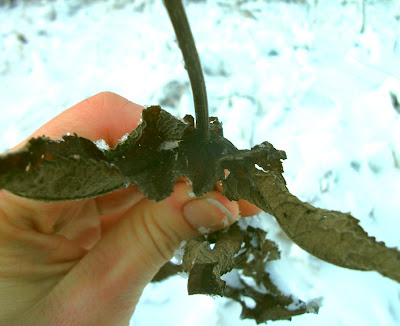With a growing passion for plant medicine and wild foods, I really value getting to know the plants in every stage of their growth, in all the seasons. For example, knowing the difference between the first and second year growth of a biennial plant and what the season is, determines whether or not the plant can be harvested. Recognising seedlings in the spring with their adorable cotyledon leaves and tiny first set of true leaves is exciting and full of anticipation. The lushness and riot of colour of plants in the summer engages all of the senses until you're drunk on the sights and scents around you.
But plants in the winter have a special magic and mystique too. They often show parts of themselves that are difficult to see at any other time. They add a wonderful architecture to the winter landscape, and sometimes even a splash of colour. I find the yellow of delicate willow branches so cheerful on grey days and the dark red of red osier dogwood against a backdrop of snow makes for a nice contrast.
Winter plants also serve an essential function in the eco-system providing food and shelter for birds and animals, like the galls on goldenrods that house two species of cold-hardy insect larvae. I can't help but have respect for all the stalks and stems that remain stoic in the face of buffeting winds, freezing temperatures and icy conditions.
When IDing plants in the winter, I find it helpful to already have an idea of where certain plants are growing. I found this boneset (Eupatorium perfoliatum) plant while out for a walk at my dad's place, because I've observed boneset growing along that stretch of road for a few years.
 Knowing the unique features of a particular plant can help with ID as well. Boneset has perfoliate leaves, which means that the leaf is united around the stem and appears to be pierced by the stem. It's a bit difficult to tell in the photo (clicking to enlarge the photo might help), but I could clearly see the perfoliate leaf, and so I knew that I found boneset.
Knowing the unique features of a particular plant can help with ID as well. Boneset has perfoliate leaves, which means that the leaf is united around the stem and appears to be pierced by the stem. It's a bit difficult to tell in the photo (clicking to enlarge the photo might help), but I could clearly see the perfoliate leaf, and so I knew that I found boneset. I don't usually like to stand around for too long, especially when the temperatures are really cold, so I'll often bring a specimen home where it's warm, where I can take a closer look, with a mug of hot tea. I could clearly see the sepals on this boneset, now that the flowers had all died back.
I don't usually like to stand around for too long, especially when the temperatures are really cold, so I'll often bring a specimen home where it's warm, where I can take a closer look, with a mug of hot tea. I could clearly see the sepals on this boneset, now that the flowers had all died back. The umbels of Queen Anne's Lace (Daucus carota), and its distinctive bird's nest shape, make this an easy plant to spot in winter.
The umbels of Queen Anne's Lace (Daucus carota), and its distinctive bird's nest shape, make this an easy plant to spot in winter. The seeds are covered in hooked, bristly hairs.
The seeds are covered in hooked, bristly hairs.

The flat-topped corymb of this yarrow (Achillea millefolium) plant looks completely different in the winter, than when it is in flower, and I might not have recognised it were it not for the few remaining, feathery leaves on the stalk.
 Burdock is one of those plants that you can identify from a vehicle going 100kms an hour, it's so obvious in the landscape.
Burdock is one of those plants that you can identify from a vehicle going 100kms an hour, it's so obvious in the landscape. A closeup of the burrs reveals the hooks which inspired the invention of Velcro, and is the bane of dog owners everywhere.
A closeup of the burrs reveals the hooks which inspired the invention of Velcro, and is the bane of dog owners everywhere. Finding rose hips in the winter landscape is a special treat. Pick the best looking, plumpest ones and bring them home to make a wonderfully tart tea. Be sure to leave some for wildlife though. They need all the help they can get at this lean time of year.
Finding rose hips in the winter landscape is a special treat. Pick the best looking, plumpest ones and bring them home to make a wonderfully tart tea. Be sure to leave some for wildlife though. They need all the help they can get at this lean time of year. I have yet to figure out what this fruiting shrub is, but the horizontal marks on the bark make me think it might be in the Prunus genus.
I have yet to figure out what this fruiting shrub is, but the horizontal marks on the bark make me think it might be in the Prunus genus.
My winter walks have taken on a whole new dimension of wonder and exploration. It's no longer a time of stark, barrenness that leaves me longing for spring. Each outing offers something new to observe, and to me, the plants are just as beautiful in their winter dress as they are in their summer finery.
No comments:
Post a Comment